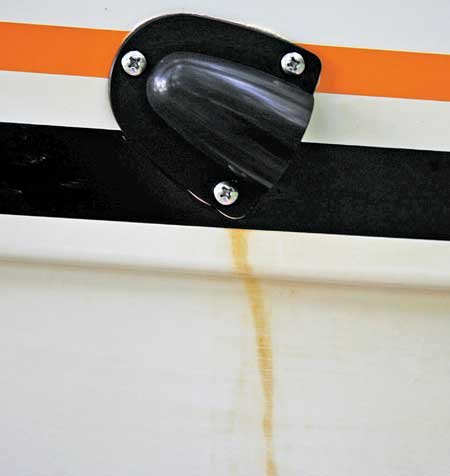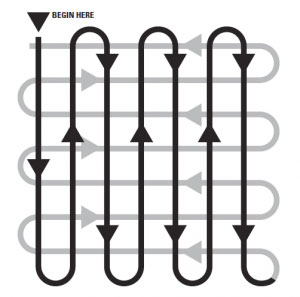Part of who we are as a company is to share our knowledge. If you want to try doing the boat polishing process yourself then please follow the process below. Call at any time if you need some tips as we are happy to help.
About your Gelcoat
Gelcoat is the coating sprayed up against a highly polished & waxed mould at the beginning of the fiberglass layup process. This process results in the smooth, mirror-like finish typical of new boats. With the passage of time, unprotected gelcoat will oxidize & eventually take on a chalky appearance. As part of this process, it becomes porous. The more porous it becomes, the more readily it will stain and streak the lower parts of the hull. The process continues until the boat becomes chalky and unsightly amongst the other boats in a marina. The good news is that nearly all gelcoat can be restored, provided it is not completely worn through to the fibre glass below.
Four Steps to Gelcoat Restoration
Step one: Remove all surface dirt. To remove the surface dirt, wash your hull and topsides with marine boat soap diluted in water. Apart from rinsing residue-free, marine boat soaps are better for the environment compared to popular dishwashing liquids, most of which are high in sulfonates and should be avoided.
Sometimes, moulded-in non-skid areas can be difficult to clean. In this case, try using a chelating non-skid cleaner. These cleaners are formulated to break the bond between the dirt and the deck without heavy scrubbing.
After removing the surface dirt inspect for damage. Look for stress cracks around stanchions or other areas that might be an indication of an underlying structural problem. Seek a boat builders advice if cracks are found on your boats surface.
Step two: Remove the stains. Nearly all boats have some degree of gelcoat staining. Unfortunately, mere soap and water frequently won’t remove all the stains, which exist at a deeper level within the porous gelcoat surface. Stains can be localised or in the case of some boats cover the entire topsides and hull. There are two types of stains: mineral and organic. Mineral stains include rust stains and “black streaks”. Organic stains include discolouration due to bird droppings, coffee, wine, and leaves.

Acid-based stain removers are the best option for removing what you see here and can be found at a store like Burnsco.
Acid-based stain removers are effective for removing most mineral & organic stains. Acid-based stain removers packaged in the form of a gel are the easiest to use, because they hold well to vertical surfaces & because they work chemically, with little or no scrubbing required. Just be careful to not leave it on the boat too long or drying in the sun as it can bleach your gelcoat colour.
When using an acid based stain remover, wear rubber gloves, eye protection, and keep it off of paint, varnish, or galvanized surfaces, as it may dull these areas.
Besides acid based stain removers, there are other formulations that target specific types of stains. These include black streak removers, rust stain removers, exhaust stain removers, mould stain removers, and even bird and spider dropping stain removers. So if you have trouble removing any of these, try using a stain remover specifically formulated to take them out.
Step three: Remove the oxidation and restore the shine. Unless your boat is very new, it most likely will have some oxidation. Light oxidation manifests itself as a slight dulling of the gelcoat. Moderate to heavy oxidation can be seen in gelcoat that has a chalk-like powder at the surface.
Before selecting a polish, it is important to understand that polishes & their more aggressive cousins, rubbing compounds use abrasives to smooth the pitted surface of porous gelcoat and restore the shine. If your gelcoat is heavily oxidized, you might need to start out with rubbing compound and then follow up with successively finer grades of polish. Bear in mind that each time these products are used, some of the gelcoat is removed. Therefore, care should be taken to use the least aggressive product that will get the job done. Polishes & rubbing compounds can be applied by machine or by hand. Always start fine and work backwards to coarse to you can maintain the fine surface of your gelcoat.
Step four: Protect the shine with a sealer or wax. Once you have polished the surface & removed the stains, it is time to seal & protect the surface with a wax or sealer. In addition to sealing out oxygen, which prevents oxidation, many waxes contain inhibitors that protect gelcoat against damaging UV light. There are several types of wax, each of which has its adherents. Choices include pure carnauba, carnauba polymer blends and polymer only formulations (sealers). Wax, like polish can be applied by machine or by hand. Do not apply wax under direct sunlight as it can scorch itself onto the surface and becomes difficult to remove. wax or seal your boats surface at one square metre at a time and remove only using a microfibre cloth.
Non-Skid cleaning
Aside from washing gelcoat non-skid areas & possibly removing the stains, most people leave their moulded-in non-skid alone. This is because they believe that polishing and waxing non-skid will make it slippery & dangerous. For old, worn non-skid this may be true. Scrub your boat hard with a medium density brush using a wash n wax boat washing formula. Do this every 4-6 weeks to stop streaking on your hull surface.
Polishing Machines
There are two types of polishing machines that you can use. The first are variable speed circular polishers, which in the hands of a pro can quickly cover a lot of ground. But when used by a novice they can “burn through” and damage the gelcoat surface. Therefore, we suggest that unless you are experienced, you use a random orbital polisher as they are much easier although slower.
Polishing Technique

For even, consistent results, follow this pattern when buffing or polishing with a machine.
When polishing or applying wax by hand or machine, work small areas in a circular manner and don’t move on until each area is done. Polishing & waxing techniques are basic, just take your time & move systematically along the boats surface.
Summary
Once you have finished the gelcoat restoration, all you need to do is follow up with regular wash downs with a wash n wax formula. We like Meguiar's wash n wax as it is high in wax content. Now go and enjoy shiney new looking boat!
